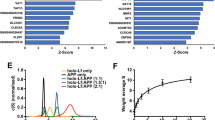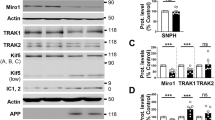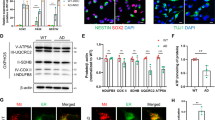Abstract
Growing evidence suggests that lactoferrin (Lf), an iron-binding glycoprotein, is a pleiotropic functional nutrient. In addition, Lf was recently implicated as a neuroprotective agent. These properties make Lf a valuable therapeutic candidate for the treatment of Alzheimer’s disease (AD). However, the mechanisms regulating the physiological roles of Lf in the pathologic condition of AD remain unknown. In the present study, an APPswe/PS1DE9 transgenic mouse model of AD was used. We explored whether intranasal human Lf (hLf) administration could reduce β-amyloid (Aβ) deposition and ameliorate cognitive decline in this AD model. We found that hLf promoted the non-amyloidogenic metabolism of amyloid precursor protein (APP) processing through activation of α-secretase a-disintegrin and metalloprotease10 (ADAM10), resulting in enhanced cleavage of the α-COOH-terminal fragment of APP and the corresponding elevation of the NH2-terminal APP product, soluble APP-α (sAPPα), which consequently reduced Aβ generation and improved spatial cognitive learning ability in AD mice. To gain insight into the molecular mechanism by which Lf modulates APP processing, we evaluated the involvement of the critical molecules for APP cleavage and the signaling pathways in N2a cells stably transfected with Swedish mutant human APP (APPsw N2a cells). The results show that the ERK1/2-CREB and HIF-1α signaling pathways were activated by hLf treatment, which is responsible for the expression of induced ADAM10. Additional tests were performed before suggesting the potential use of hLf as an antioxidant and anti-inflammatory. These findings provide new insights into the sources and mechanisms by which hLf inhibits the cognitive decline that occurs in AD via activation of ADAM10 expression in an ERK1/2-CREB and HIF-1α-dependent manner.
Similar content being viewed by others
Log in or create a free account to read this content
Gain free access to this article, as well as selected content from this journal and more on nature.com
or
References
Abbott A (2008). Neuroscience: the plaque plan. Nature 456: 161–164.
Aisen P, Leibman A (1972). Lactoferrin and transferrin: a comparative study. Biochim Biophys Acta 257: 314–323.
Akiyama H, Barger S, Barnum S, Bradt B, Bauer J, Cole GM et al (2000). Inflammation and Alzheimer's disease. Neurobiol Aging 21: 383–421.
Arnold RR, Cole MF, McGhee JR (1977). A bactericidal effect for human lactoferrin. Science 197: 263–265.
Barsoum IB, Hamilton TK, Li X, Cotechini T, Miles EA, Siemens DR et al (2011). Hypoxia induces escape from innate immunity in cancer cells via increased expression of ADAM10: role of nitric oxide. Cancer Res 71: 7433–7441.
Barsoum IB, Hamilton TK, Li X, Cotechini T, Miles EA, Siemens DR et al (2012). Hypoxia induces escape from innate immunity in cancer cells via increased expression of ADAM10: role of nitric oxide. Cancer Res 71: 7433–7441.
Calsolaro V, Edison P (2016). Neuroinflammation in Alzheimer's disease: current evidence and future directions. Alzheimers Dement 12: 719–732.
Cao G, Zhu J, Zhong Q, Shi C, Dang Y, Han W et al (2013). Distinct roles of methamphetamine in modulating spatial memory consolidation, retrieval, reconsolidation and the accompanying changes of ERK and CREB activation in hippocampus and prefrontal cortex. Neuropharmacology 67: 144–154.
Crapper McLachlan DR, Dalton AJ, Kruck TP, Bell MY, Smith WL, Kalow W et al (1991). Intramuscular desferrioxamine in patients with Alzheimer's disease. Lancet 337: 1304–1308.
Daulatzai MA (2016). Fundamental role of pan-inflammation and oxidative-nitrosative pathways in neuropathogenesis of Alzheimer's disease in focal cerebral ischemic rats. Am J Neurodegener Dis 5: 102–130.
Fillebeen C, Ruchoux MM, Mitchell V, Vincent S, Benaissa M, Pierce A (2001). Lactoferrin is synthesized by activated microglia in the human substantia nigra and its synthesis by the human microglial CHME cell line is upregulated by tumor necrosis factor alpha or 1-methyl-4-phenylpyridinium treatment. Brain Res Mol Brain Res 96: 103–113.
Fuller S, Steele M, Munch G (2010). Activated astroglia during chronic inflammation in Alzheimer's disease—do they neglect their neurosupportive roles? Mutat Res 690: 40–49.
Garcia-Montoya IA, Cendon TS, Arevalo-Gallegos S, Rascon-Cruz Q (2012). Lactoferrin a multiple bioactive protein: an overview. Biochim Biophys Acta 1820: 226–236.
Guo C, Hao LJ, Yang ZH, Chai R, Zhang S, Gu Y et al (2016). Deferoxamine-mediated up-regulation of HIF-1alpha prevents dopaminergic neuronal death via the activation of MAPK family proteins in MPTP-treated mice. Exp Neurol 280: 13–23.
Guo C, Wang T, Zheng W, Shan ZY, Teng WP, Wang ZY (2013). Intranasal deferoxamine reverses iron-induced memory deficits and inhibits amyloidogenic APP processing in a transgenic mouse model of Alzheimer's disease. Neurobiol Aging 34: 562–575.
Guo C, Zhang YX, Wang T, Zhong ML, Yang ZH, Hao LJ et al (2015). Intranasal deferoxamine attenuates synapse loss via up-regulating the P38/HIF-1alpha pathway on the brain of APP/PS1 transgenic mice. Front Aging Neurosci 7: 104.
Ikoma-Seki K, Nakamura K, Morishita S, Ono T, Sugiyama K, Nishino H et al (2015). Role of LRP1 and ERK and cAMP signaling pathways in lactoferrin-induced lipolysis in mature rat adipocytes. PLoS One 10: e0141378.
Iwamaru Y, Shimizu Y, Imamura M, Murayama Y, Endo R, Tagawa Y et al (2008). Lactoferrin induces cell surface retention of prion protein and inhibits prion accumulation. J Neurochem 107: 636–646.
Jiang R, Lopez V, Kelleher SL, Lonnerdal B (2011). Apo- and holo-lactoferrin are both internalized by lactoferrin receptor via clathrin-mediated endocytosis but differentially affect ERK-signaling and cell proliferation in Caco-2 cells. J Cell Physiol 226: 3022–3031.
Johnson EE, Wessling-Resnick M (2012). Iron metabolism and the innate immune response to infection. Microbes Infect 14: 207–216.
Kamalinia G, Khodagholi F, Atyabi F, Amini M, Shaerzadeh F, Sharifzadeh M et al (2013). Enhanced brain delivery of deferasirox-lactoferrin conjugates for iron chelation therapy in neurodegenerative disorders: in vitro and in vivo studies. Mol Pharm 10: 4418–4431.
Kawamata T, Tooyama I, Yamada T, Walker DG, McGeer PL (1993). Lactotransferrin immunocytochemistry in Alzheimer and normal human brain. Am J Pathol 142: 1574–1585.
Kim J, Lilliehook C, Dudak A, Prox J, Saftig P, Federoff HJ et al (2010). Activity-dependent alpha-cleavage of nectin-1 is mediated by a disintegrin and metalloprotease 10 (ADAM10). J Biol Chem 285: 22919–22926.
Kontoghiorghes GJ, Kolnagou A, Skiada A, Petrikkos G (2010). The role of iron and chelators on infections in iron overload and non iron loaded conditions: prospects for the design of new antimicrobial therapies. Hemoglobin 34: 227–239.
Krasnova IN, Chiflikyan M, Justinova Z, McCoy MT, Ladenheim B, Jayanthi S et al (2013). CREB phosphorylation regulates striatal transcriptional responses in the self-administration model of methamphetamine addiction in the rat. Neurobiol Dis 58: 132–143.
Kruzel ML, Actor JK, Radak Z, Bacsi A, Saavedra-Molina A, Boldogh I (2010). Lactoferrin decreases LPS-induced mitochondrial dysfunction in cultured cells and in animal endotoxemia model. Innate Immun 16: 67–79.
Lammich S, Kojro E, Postina R, Gilbert S, Pfeiffer R, Jasionowski M et al (1999). Constitutive and regulated alpha-secretase cleavage of Alzheimer's amyloid precursor protein by a disintegrin metalloprotease. Proc Natl Acad Sci USA 96: 3922–3927.
Leveugle B, Spik G, Perl DP, Bouras C, Fillit HM, Hof PR (1994). The iron-binding protein lactotransferrin is present in pathologic lesions in a variety of neurodegenerative disorders: a comparative immunohistochemical analysis. Brain Res 650: 20–31.
Liu L, Zhu J, Zhou L, Wan L (2016). RACK1 promotes maintenance of morphine-associated memory via activation of an ERK-CREB dependent pathway in hippocampus. Sci Rep 6: 20183.
Mattson MP, Cheng B, Culwell AR, Esch FS, Lieberburg I, Rydel RE (1993). Evidence for excitoprotective and intraneuronal calcium-regulating roles for secreted forms of the beta-amyloid precursor protein. Neuron 10: 243–254.
Mayeur S, Spahis S, Pouliot Y, Levy E (2015). Lactoferrin, a pleiotropic protein in health and disease. Antioxid Redox Signal 24: 813–836.
Orsi N (2004). The antimicrobial activity of lactoferrin: current status and perspectives. Biometals 17: 189–196.
Qian ZM, Wang Q (1998). Expression of iron transport proteins and excessive iron accumulation in the brain in neurodegenerative disorders. Brain Res Brain Res Rev 27: 257–267.
Ran I, Laplante I, Lacaille JC (2012). CREB-dependent transcriptional control and quantal changes in persistent long-term potentiation in hippocampal interneurons. J Neurosci 32: 6335–6350.
Rousseau E, Michel PP, Hirsch EC (2013). The iron-binding protein lactoferrin protects vulnerable dopamine neurons from degeneration by preserving mitochondrial calcium homeostasis. Mol Pharmacol 84: 888–898.
Selkoe DJ (1989). Amyloid beta protein precursor and the pathogenesis of Alzheimer's disease. Cell 58: 611–612.
Selkoe DJ (2002). Alzheimer's disease is a synaptic failure. Science 298: 789–791.
Shukla M, Htoo HH, Wintachai P, Hernandez JF, Dubois C, Postina R et al (2015). Melatonin stimulates the nonamyloidogenic processing of betaAPP through the positive transcriptional regulation of ADAM10 and ADAM17. J Pineal Res 58: 151–165.
Takase K (1998). Reactions of denatured proteins with other cellular components to form insoluble aggregates and protection by lactoferrin. FEBS Lett 441: 271–274.
Turner PR, O'Connor K, Tate WP, Abraham WC (2003). Roles of amyloid precursor protein and its fragments in regulating neural activity, plasticity and memory. Prog Neurobiol 70: 1–32.
van de Looij Y, Ginet V, Chatagner A, Toulotte A, Somm E, Huppi PS et al (2014). Lactoferrin during lactation protects the immature hypoxic-ischemic rat brain. Ann Clin Transl Neurol 1: 955–967.
Vardy ER, Catto AJ, Hooper NM (2005). Proteolytic mechanisms in amyloid-beta metabolism: therapeutic implications for Alzheimer's disease. Trends Mol Med 11: 464–472.
Velusamy SK, Poojary R, Ardeshna R, Alabdulmohsen W, Fine DH, Velliyagounder K (2014). Protective effects of human lactoferrin during Aggregatibacter actinomycetemcomitans-induced bacteremia in lactoferrin-deficient mice. Antimicrob Agents Chemother 58: 397–404.
Vincent B, Govitrapong P (2011). Activation of the alpha-secretase processing of AbetaPP as a therapeutic approach in Alzheimer's disease. J Alzheimers Dis 24 (Suppl 2): 75–94.
Wan XZ, Li B, Li YC, Yang XL, Zhang W, Zhong L et al (2012). Activation of NMDA receptors upregulates a disintegrin and metalloproteinase 10 via a Wnt/MAPK signaling pathway. J Neurosci 32: 3910–3916.
Wang J, Bi M, Liu H, Song N, Xie J (2015). The protective effect of lactoferrin on ventral mesencephalon neurons against MPP+ is not connected with its iron binding ability. Sci Rep 5: 10729.
Wang L, Sato H, Zhao S, Tooyama I (2010). Deposition of lactoferrin in fibrillar-type senile plaques in the brains of transgenic mouse models of Alzheimer's disease. Neurosci Lett 481: 164–167.
Williams P, Sorribas A, Howes MJ (2011). Natural products as a source of Alzheimer's drug leads. Nat Prod Rep 28: 48–77.
Yan D, Chen D, Hawse JR, van Wijnen AJ, Im HJ (2013). Bovine lactoferricin induces TIMP-3 via the ERK1/2-Sp1 axis in human articular chondrocytes. Gene 517: 12–18.
Zakharova ET, Kostevich VA, Sokolov AV, Vasilyev VB (2012). Human apo-lactoferrin as a physiological mimetic of hypoxia stabilizes hypoxia-inducible factor-1 alpha. Biometals 25: 1247–1259.
Author information
Authors and Affiliations
Corresponding authors
Rights and permissions
About this article
Cite this article
Guo, C., Yang, ZH., Zhang, S. et al. Intranasal Lactoferrin Enhances α-Secretase-Dependent Amyloid Precursor Protein Processing via the ERK1/2-CREB and HIF-1α Pathways in an Alzheimer’s Disease Mouse Model. Neuropsychopharmacol. 42, 2504–2515 (2017). https://doi.org/10.1038/npp.2017.8
Received:
Revised:
Accepted:
Published:
Issue date:
DOI: https://doi.org/10.1038/npp.2017.8
This article is cited by
-
Design and Evaluation of Lactoferrin-Conjugated Cur-M-PCL Nanocarriers for Targeted Glioblastoma Multiforme Therapy
BioNanoScience (2025)
-
Non-invasive Biomarkers for Early Detection of Alzheimer’s Disease: a New-Age Perspective
Molecular Neurobiology (2024)
-
Lactoferrin Protects Against Rotenone-Induced Toxicity in Dopaminergic SH-SY5Y Cells through the Modulation of Apoptotic-Associated Pathways
Journal of Molecular Neuroscience (2024)
-
Therapeutic potential of ADAM10 modulation in Alzheimer’s disease: a review of the current evidence
Cell Communication and Signaling (2023)
-
The Role of ERK1/2 Pathway in the Pathophysiology of Alzheimer’s Disease: An Overview and Update on New Developments
Cellular and Molecular Neurobiology (2023)



